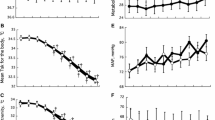Summary
We have studied the effect of histamine and H1- or H2-receptor antagonists on cutaneous blood flow and catecholamine release in man.
Histamine was infused alone or in combination with mepyramine, an H1-antagonist or cimetidine, an H2-antagonist for 2 h. Cutaneous blood flow was measured continously with a laser Doppler flowmeter, and noradrenaline and adrenaline concentrations were determined in blood samples drawn every 15 min.
The infusion of histamine caused an immediate and sustained vasodilatation. The Concomitant infusion of mepyramine prevented the immediate vasodilatation, but had no effect on the sustained response. The Concomitant infusion of cimetidine was without effect on the immediate vasodilatation, but abolished the sustained response. Infusion of the antagonists alone had no effect on cutaneous blood flow.
Histamine caused a rapid and sustained increase in plasma noradrenaline, while the increase during concomitant H1-receptor blockade was delayed but achieved the level observed during the histamine infusion. The response to histamine during H2-receptor blockade was small and transient. The rise in plasma adrenaline was not significant.
These findings suggest that histamine causes an immediate cutaneous vasodilatation through H1-receptors and a more sustained response through H2-receptors. The vasodilatation is accompanied by an increase in plasma catecholamine concentrations. Despite the continuous infusion of histamine, blood flow decreased during the last hour of histamine infusion, while the plasma noradrenaline concentration was still elevated.
Similar content being viewed by others
References
Ambrus JI, Ambrus CM, Harrisson JWE (1951) Effect of histamine desensitization on histamine induced gastric secretion of guinea pigs. Gastroenterology 18: 249–253
Banks RO, Fondacaro JD, Schwaiger MM, Jacobsen ED (1978) Renal histamine H1 and H2 receptors: Characterization and functional significance. Am J Physiol 235: F570-F575
Ben-Jonathan N, Porter JC (1976) A sensitive radioenzymatic assay for dopamine, norepinephrine, and epinephrine in plasma and tissue. Endocrinology 98: 1497–1507
Black JW, Owen DAA, Parsons ME (1975) An analysis of the depressor responses to histamine in the cat and dog: Involvement of both H1- and H2-receptors. Br J Pharmacol 54: 319–324
Boyce MJ (1982) Pharmacological characterisation of cardiovascular histamine receptors in man in vivo. Klin Wochenschr 60: 978–982
Brimblecombe RW, Qwen DAA, Parsons ME (1974) The cardiovascular effects of histamine in laboratory animals. Agents Actions 4: 191–192
Chipman P, Glover WE (1976) Histamine H2-receptors in the human peripheral circulation. Br J Pharmacol 56: 494–496
Cochrane T, Earnshaw JC, Love AHG (1981) Laser Doppler measurements of blood velocity in microvessels. Med Biol Eng Comput 19: 589–596
Engelhart M, Kristensen YK (1983) Evaluation of cutaneous blood flow responses by 133Xenon washout and a laser Doppler flowmeter. J Invest Dermatol 80: 12–15
Fermont DC, Haggie SJ, Wyllie JH (1976) Histamine receptors in human skin. Br J Surg 63: 160
Harvey CA, Owen DAA (1980) Time dependence of the interaction between histamine and histamine receptor antagonists in the cardiovascular system. Br J Pharmacol 68: 187 P
Holloway GA (1983) Laser Doppler measurements of cutaneous blood flow. In: Rolfe P (eds) Non-invasive measurements, vol 2. Academic Press, London, pp 219–249
Johnston BM, Owen DAA (1977) Tissue blood flow and distribution of cardiac output in cats: Changes caused by intravenous infusions of histamine and histamine receptor agonists. Br J Pharmacol 60: 173–180
Karady S (1936) Über experimentelle Tieruntersuchungen zur Frage der Histamintachyphylaxie und Histaminresistenz. Arch Exp Pathol Pharmacol 180: 283–289
Kramer CY (1956) Extension of multiple range tests to group means with unequal numbers of replications. Biometrics 12: 307–310
Levi R, Hordof A, Edie A et al. (1978) Histamine effects on human atria. Circulation 58: 101–105
Marks R, Greaves MV (1977) Vascular reactions to histamine and compound 48/80 in human skin: Suppression by histamine H2-receptor blocking agent. Br J Clin Pharmacol 4: 367–369
Nilsson GE, Tenland T, Oberg PA (1980) Evaluation of a Laser Doppler flowmetry for measurements of tissue blood flow. IEEE Trans Biomed Eng BME 27: 597–604
Owen DAA, Harvey CA, Boyce MJ (1982) Effects of histamine on the circulatory system. Klin Wochenschr 60: 972–977
Parratt JR (1969) The effect of histamine on myocardial circulation. Eur J Pharmacol 6: 203–208
Pawlik W, Tague LL, Tepperman BL, Miller TA, Jacobsen ED (1977) Histaminie H1- and H2-receptor vasodilatation on canine intestinal circulation. Am J Physiol 233: E219-E224
Powell JR, Brody MJ (1976) Participation of H1- and H2-histamine receptors in physiological vasodilatory responses. Am J Physiol 231: 1002–1009
Smith DJ, Robinson RL (1970) The dwilling secretory response of the perfused adrenal medulla of the cat to repeated injections of histamine. J Pharmacol Exp Ther 175: 641–648
Smith R, Grossman A, Boyce MJ, Besser GM, Rees LH (1985) Effect of histamine infusion on circulating methionine-enkephalin and catecholamine concentration. Neurosci Lett 55: 289–292
Vigorito C, Russo P, Picotti GB, Chiariello M, Poto S, Marone G (1983) Cardiovascular effects of histamine infusion in man. J Cardiovasc Pharmacol 5: 531–537
Author information
Authors and Affiliations
Rights and permissions
About this article
Cite this article
Knigge, U., Alsbjørn, B., Thuesen, B. et al. Temporal responses of cutaneous blood flow and plasma catecholamine concentrations to histamine H1- or H2-receptor stimulation in man. Eur J Clin Pharmacol 33, 613–617 (1988). https://doi.org/10.1007/BF00542497
Received:
Accepted:
Issue Date:
DOI: https://doi.org/10.1007/BF00542497




